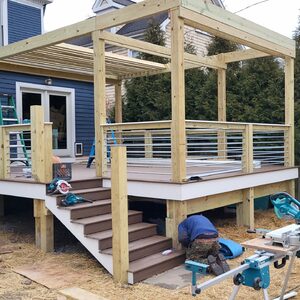My husband and I enjoy DIY projects when they’re manageable. Right now we’re working on a little boat house at our cabin. (Actually, it’s a “boat stuff” house, at 8×10, it’s too small for anything but our kayak. However, it will hold gas, motors, fishing poles, dead leeches, etc. I’m sure all you fishermen out there have the picture.) Yes, we have a permit, and no, it doesn’t interfere with anyone’s sight line! We are intentionally staying within all codes for boat houses, one goal of which is to keep it unobtrusive.
Our goal in this is to make the little boat house blend in with the trees it’s sheltered by. Plus, we wanted it to have an “old” look, like it was built 80 years ago. So, it has T&G carsiding on the walls rather than OSB, and shiplap on the roof instead of plywood. I’ve sanded and stained the wood before construction in several subtle shades of green and blue, and it has some cedar trim. (Had a lot of fun telling the neighbors it was made of “blue spruce”.) We added routed rafter tails, and an extended roof line, as well as king-post beams inside. It hasn’t been very expensive up until now, just time-consuming.
We’ve decided that to complete the shed, we really need a cedar shake roof. Actually, that’s not really true; I decided we needed a cedar shake roof. My husband would like to just put on asphalt shingles, and I can’t blame him. But, he’s agreed, since it’s less than 10′ tall and less than 2 squares of simple roof lines, to go along.
I’m certain he agreed, in part, because I agreed that if we did the roof in cedar shakes, we could get a new power tool to put on the shakes. The cedar folks suggest a medium crown stapler with stainless steel staples. We already have 3 power nailers or staplers, but we don’t have this one. I’ve searched the Fine Homebuilding archives for a tool comparison, but can’t find any.
OK, so here’s my question: I have read reviews of the Porter Cable MS200 and the Senco SNS40 Power Staplers. Any experienced users out there to steer me one way or the other? Any other suggestions for a small cedar shake roof? Probably not much more work to do it with nailing by hand, but there are some upcoming projects that we can use it for, as well. Thanks in advance! I’ve been away from Breaktime for several years, as I haven’t been able to figure out the log-in system, but I really need the answer to this one, so I’m more determined, now.


















Replies
That is a long and impresive saga. I have done more than a few shake roofs and don't care for stapels so I can't advise you on the comparison other than to repeat from what I have heard here and elsewhere, that the PC tools are disappointing.
For only a couple of squares, I would put the money to better use, lik ew anew router. I only have four or five.
Excellence is its own reward!
You sound like a guy that knows what he's doing! So, would we be better off just nailing the shakes? And, would it help to lay them out on the ground or a wood deck ahead of time so we're not "fumbling around" looking for the right size shake on the roof? Any other advice you can give?
Nails are always better. Study the literature from the shake people about depth to set nail head. too deep shoretens life of shake by introducing a split.
After all these years, I can spot by eye the right width to snake out of the pile but not even for a beginner would I recommend spreading them all over kingdom come. Best is to do it together, One can spot and place shakes and the other can nail..
Excellence is its own reward!
If you don't want to answer these questions, because it seems too long, I will understand; just let me know you don't have time. These are our final (I hope) questions about this project:
1) The manual suggests a 1" overhang on the roof edge. We are planning to nail it to spacer boards so that the nails don't come through the sheathing on the underside, and so it can breathe. Do you allow for the 3/4" trim board you'll put up after the shakes are in place to cover up the spacer board, and go with a 1 and 3/4" overhang? Or, do you have a 1" overhang and put up the trim boards, leaving a 1/4" overhang?
2) We are putting ice and water dam over the entire shed roof. (Poly, not granular.) Would you still bother with the tar paper on each course?
3) Some people recommend soaking the cedar shakes so they're not so brittle when nailing. Is this a good idea? Overkill?
4) Ideally, we'd like to apply Penofin cedar stain, but it's supposed to weather for 30 days first, and we're running out of fall. We've also heard that it's such a hassle to stain cedar shakes, to just let it go. Could we stain it in the spring? If the stain only lasts 2-3 years, that's maybe more maintenence than we want, I don't know. Thoughts on this?
5) I was looking at applying copper strips to the very top of the ridge cap shingles with that new construction adhesive that sticks to anything. Would this be an "ok" thing?
Thanks in advance for any advice you can give us!!
I like a 2" overhang after the trim so if the trim is not on yet, I would overhang by 2-3/4" on the eaves.
Up the rake on the gable end, water won't be streaming off so an ich after trim is fine.
2> The felt woven between courses is more important than the I&W IMO. Do you understand how to weave it or should I draw a diagram? This felt is what kicks wind blown water back on top of the lower course of shingles to keep it streaming down and off instead of finding a way in. If you put down I&W, then strapping and then shingles, each course of strapping would act as a damn to hinder runoff. Water held in place can and will find a way in.
3> Soaking...
I've seen it done in Texas and I understand the reasoning. I've never needed to but it probably won't hurt if you want to do it. Keep your spacing a little claoser - maybe 1/4" or so
4> I've never treated or stained shakes. Don't see any reason to unless there is a need for the colour. I know you've enjoyed doing this little project but it's probably time to put a cap on it and say, "Well done, now let's enjoy it"
5> Zinc or copper strips will impede the growth of moss on the roof. Not sure of the glue you mention. I might just use 3d fine for tacking it on. But my prefered method would be this - figure where the edge of the ridge shingles wqill be, approximately, after you lay up the shakes to the ridge and cut them off. Then tack a 3" wide zinc strip on each side so that an inch protrudes from beneath the ridge. Then install the ridge pieces over that. Exposed nails are minimaized that way.
If you rely on glue and it fails, you will be left with a less than pretty scar along the top..
Excellence is its own reward!
Thanks so much for the information! It's supposed to be highs in the upper 40's this weekend, so it's warm enough to work, just not comfortable.
One last question: would it be helpful to predrill the shakes? That way we'd know where to pound the nails, and they would be less likely to split. I know it's extra work, but I've nothing better to do, anyway. Just a thought to save a little "up on the roof" time!
You've got too much time on your hands, darling!
I don't suppose it would hurt but I've never heard of it before. OK if you do it before setting in place but if you tried to hold the shake in place to do it, and it shifted, you would have a hole that wouldn't do you any good.
You say you domn't have enything else to do anyway but laying shakes works well with two people. One can select, set, and hold while the other nails..
Excellence is its own reward!
Thanks for all your suggestions! The scaffolding is loaded along with a square of shingles. We do well with two-person projects, although we do NOT resemble Dean Johnson and JoAnn Liebler from "Hometime" on cable TV, where every board fits with never a cross word between them! I think we'll actually have fun with the shake roof, and it will look great! Thanks again.....
Dat's gut!
With all the extra fine detailing you have done, a picture in the photo gallerywould be nice when you are done.
Maybe an "American Gothic - The Shed"
;)
Have fun.
Excellence is its own reward!
Well, we're not ready for pictures, yet, but the cedar shake roof is coming along! We're really happy with the appearance, and we're almost 1/2 done. We did get off a little bit on one row, where we snapped a chalk line on the cedar, and we didn't notice it had snagged on one of the shakes. But, we fixed it on the next row, and it's not noticeable.
At first, working with cedar shakes drove my husband crazy, because they're so haphazardly shaped, and they don't make a nice neat row. Because he's not a "measure twice, cut once" kind of DIY. He's a "measure 5 times, then double check once more to make sure, then cut it long, just to be on the safe side, and then cut a blade off because it's a little long" kind of guy. In fact, in the last Fine Homebuilding, there was an article on "Ten Ways to Work Faster". After reading the article, I had to tease my husband a little bit, that they must have been watching him to know what NOT to do to work faster. He would NEVER, for example, cut a top plate 1/4" short even if it made sense to do so. Which is fine with me; we're in no hurry, and it always looks nice when we're done. So, the cedar shakes are way outside his comfort level, because they don't fit any general idea of perfection. He did get used to it after the first few rows.
Anyway, we have another question for you or anyone else that wants to chime in here, because we have to know this by tomorrow.
What happens at the top of the roof? By our figuring, we will end up with three strips of roofing felt protruding at the top. We know that one of the felt rows is overlapped a couple of inches over the top of the last row of shingles. We're guessing that the other two get trimmed off at the top edge. Which one is overlapped, or doesn't it matter? I presume we still keep putting the 18" of felt down on each row, regardless.
We have ordered pre-made cedar caps for the ridge, and we'll be putting on a "Cobra" ridge vent, which we're very familiar with, unless anyone objects, here. As suggested, we'll nail down a copper strip to the top edge so that the copper protrudes about an inch from the roof cap edge, to cut down on mold and lichens.
We have enjoyed doing the 2 squares, but think that anyone who tackles a large roof with cedar shakes is underpaid! What a lot of work!!!! Pictures will be forthcoming - eventually.........
Thanks again for all the help and suggestions!
For the ridge vent to work ypu need to omit or cut back the last couple of layers of felt. Otherwise, you're on the right track.
i've never seen ridge vent and cedar caps together. The performed cedar caps are too narrow for a ridge vent. If I remember right, this is just a storage shed so you wouldn't need venting.
Excellence is its own reward!
Benjamin Obdyke and several others make a ridge vent just for cedar shake and shingle ridges. It's about 8 inches wide.
Hot Dog!
Love it when I learn something new.
Tanks.
Excellence is its own reward!
One last cedar shake question. (It's turning out very nicely, and we are so proud! ) Anyway, when it comes to trim, we can trim out the roof sheathing and the spacer boards with a frieze board; no problem. But, how do you trim out the funny angle formed by the shakes on top of the spacer boards? Because we're certain that bats are going to get in those little spaces. We're not opposed to bats in principle, you understand, but just don't want to have them messing up the shed.
Any thoughts out there?
Sigh... we are in the middle of tearing off an 82 square cedar roof. I can't get away from it. It haunts my dreams at night :)
Staples - Staples everywhere! aaaaggghhhhh!
So what is the average life span of an untreated ceadar roof?
This seems like the thread for another cedar shingle question that's been bugging me. In threads from the archives, and in a past FHB article I've read that cedar shingles, should be laid on the roof with the pith side down. Does anyone have an explanation as to why this is so?
Thanks,
Fred
with the pith down minimizes the cupping/gull wing. that all matters what the course exposure or to the weather factor is. the larger shingles around 8" wide or some call bed sheets. i save for dormer walls. i split anything more than 8-10" wide i split in half for roofs.
back to the gull wing factor if they cup up the weather will permeate under the shingle which will cause a weak link in the overlapping that takes place with the weather than the head lap."expectations are premeditated resentments"
Thanks for the reply.
"with the pith down minimizes the cupping/gull wing"
I'm not sure I worded my post very well. It makes sense to lay the shingle so that if it cupped, it would cup downward. What I don't understand is why the shingle would cup toward the pith side.
fred
"the more I know about it, the less I understand"
It could be to increase the likelihood of any curling being toward the roof rather than up at the corners or the ends. Since most shakes are made from pretty large logs and are not split right next to the pith I think the usefulness of this advice would be minimal in practical application.
wnv- i wont go into a long breathy story so long story short. go with nails had to tie an old barn wall with a recently shaked roof , 7 years ago. on one side (the roof was an up and over simple gable)they used nails, and on the other staples. layed over tradional skip sheathing, and the staple side was a snap to strip and weave the new shingles in .when lifted the 2 course up and 3 shingles left were lifting up. the staples we're 1 1/2" long ,then were switched to 2" 3 courses up. the whole roof when walked on has fragile demeanor as opposed to the side that 's nailed which tight and sound. and has a better overall apperance, less cup's, cracks ,and other after effects when layed( the nailed side that is ). i checked the skip sheathing and it was secured and consistently nailed on the true 2 x 8 rafter's. i use a hitachi nv 65 coil with a 2" ring shank. and it's the way to go but for a small roof hand nailing is the way to go . there another issue i have with staple and that with the double leg on each staple , when the shingle shrinks and swell with the weather the shingles have more of a tendecy to crack. that an observation , that pretty consistent around here. i'm sure geographic location plays a role in that application i'm on eastern seaboard .... stay well bear
"expectations are premeditated resentments"
Edited 10/1/2003 8:22:14 PM ET by the bear
Thanks for the suggestion! I think we're just going to go with nails, and hope for the best in terms of time. The whole point is to have fun making a "new-old" building, anyway, so it makes sense to use older methods of fastening!
The difference between the two models of guns you mentioned will probably not be of concern to a DIY occasional user. The Senco would be the choice for heavy all day everyday use. Porter Cable is much less expensive in my neighborhood but still a fine tool. I would not buy a gun just for a small roof, you have a hammer right?